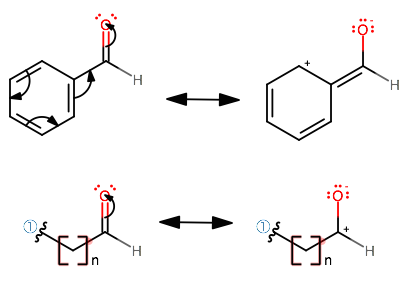Why are aromatic aldehydes less reactive than aliphatic aldehydes?
1 Answer
I'm just going to give an alternative approach to the answer.
How I think about it is via resonance structures. Here's an example of an aromatic aldehyde, as compared to an aliphatic aldehyde:

AROMATIC ALDEHYDES
The
As a result, it extends the delocalization of the
Thus, you can see that the presence of the aromatic ring makes the carbonyl carbon less electrophilic through the redistribution of the electropositivity throughout the aromatic ring instead of just on the carbonyl carbon.
If you think about it like glasses of water, then that means the widespread distribution decreases the amount of positive charge (water) on each electropositive carbon (in each glass).
ALIPHATIC ALDEHYDES
On the other hand, an aliphatic aldehyde doesn't have that adjacency to an aromatic ring, so it doesn't have some resonance stabilization that makes the carbonyl carbon less acidic/electrophilic. Or, you could say that the aliphatic aldehyde "puts its water in only one glass".
Therefore, the greater electrophilicity of the aliphatic aldehyde's carbonyl carbon makes it more reactive.

